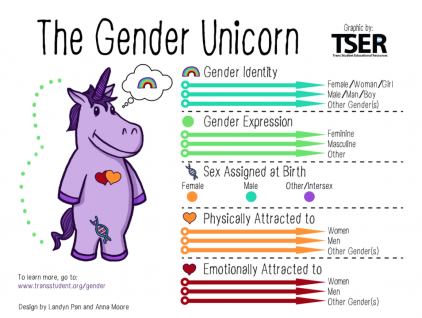Campus Living Housing Definitions
For students who want more information about some of the vocabulary used in our housing process, here is a list of terminology that might be relevant.
The following definitions are from TSER: Trans Student Educational Resources. You can learn more about gender definitions on their website: https://transstudent.org/about/definitions/.
Definitions Related to Gender and Gender Expression
We acknowledge that gender is personal and constantly evolving. We will work to update this list often.
LGBTQIAPP+: A collection of identities short for lesbian, gay, bisexual, trans, queer, questioning, intersex, asexual, aromantic, pansexual, polysexual (sometimes abbreviated to LGBT or LGBTQ+). Sometimes this acronym is replaced with “queer.” Note that “ally” is not included in this acronym.
Gender: One’s internal sense of being male, female, neither of these, both, or other gender(s). Everyone has a gender identity, including you. For transgender people, their sex assigned at birth and their gender identity are not necessarily the same.
Cisgender/ Cis: Term for someone who exclusively identifies as their sex assigned at birth. The term cisgender is not indicative of gender expression, sexual orientation, hormonal makeup, physical anatomy, or how one is perceived in daily life.
Transgender/ Trans: Encompassing term of many gender identities of those who do not identify or exclusively identify with their sex assigned at birth. The term transgender is not indicative of gender expression, sexual orientation, hormonal makeup, physical anatomy, or how one is perceived in daily life.
Nonbinary: Preferred umbrella term for all genders other than female/male or woman/man, used as an adjective (e.g. Jesse is a nonbinary person). Not all nonbinary people identify as trans and not all trans people identify as nonbinary. Sometimes (and increasingly), nonbinary can be used to describe the aesthetic/presentation/expression of a cisgender or transgender person.
Gender expression/presentation: The physical manifestation of one’s gender identity through clothing, hairstyle, voice, body shape, etc. (typically referred to as masculine or feminine). Many transgender people seek to make their gender expression (how they look) match their gender identity (who they are), rather than their sex assigned at birth. Someone with a gender nonconforming gender expression may or may not be transgender.
Gender identity: One’s internal sense of being male, female, neither of these, both, or other gender(s). Everyone has a gender identity, including you . For transgender people, their sex assigned at birth and their gender identity are not necessarily the same.
Sex assigned at birth: The assignment and classification of people as male, female, intersex, or another sex assigned at birth often based on physical anatomy at birth and/or karyotyping.
The following definitions are from the Lesbian, Gay, Bisexual, Transgender, Queer Plus (LGBTQ+) Resource Center. You can learn more about pronouns on their website: https://uwm.edu/lgbtrc/support/gender-pronouns/.
Definitions Related to Pronouns:
Pronouns: A pronoun is a word that refers to either the people talking (I or you) or someone or something that is being talked about (like she, it, them, and this). Gender pronouns (he/she/they/ze etc.) specifically refer to people that you are talking about.
She/her/hers and he/him/his are a few commonly used pronouns. Some people call these “female/feminine” and “male/masculine” pronouns, but many avoid these labels because not everyone who uses he feels like a “male” or “masculine.”
There are also lots of gender-neutral pronouns in use. Here are a few you might hear:
- They/them/theirs (Shea ate their food because they were hungry.) This is a pretty common gender-neutral pronoun and it can be used in the singular. In fact, “they” was voted as the Word of the Year in 2015.
- Ze/hir/hir (Tyler ate hir food because ze was hungry.) Ze is pronounced like “zee” can also be spelled zie or xe, and replaces she/he/they. Hir is pronounced like “here” and replaces her/hers/him/his/they/theirs.
- Just my name please! (Ash ate Ash’s food because Ash was hungry) Some people prefer not to use pronouns at all, using their name as a pronoun instead.

Campus Living is located in Odell Annex on the Undergraduate Campus.
MSC: 132
email living@lclark.edu
voice 503-768-7123
The Office of Campus Living
living@lclark.edu
Main Office: 503-768-7123
RA on Call: 503-768-8999
Campus Living
Lewis & Clark
615 S. Palatine Hill Road MSC 132
Portland OR 97219
